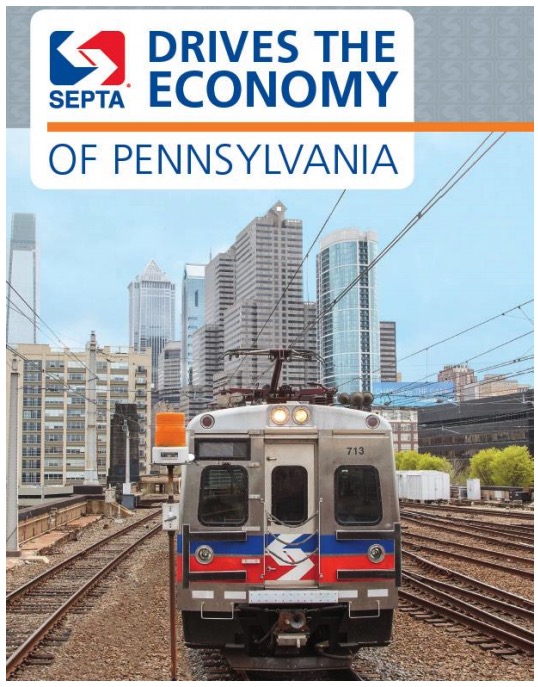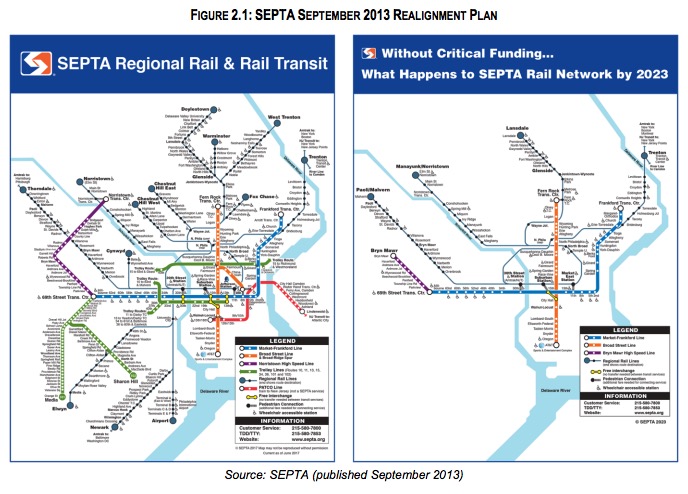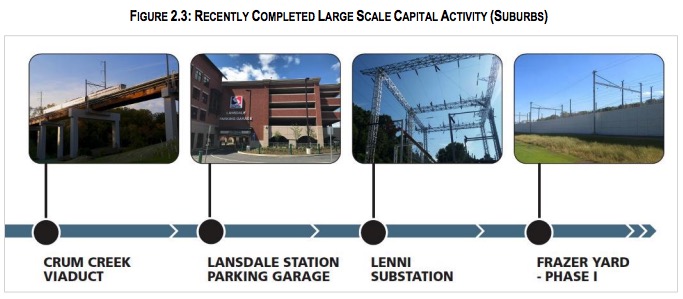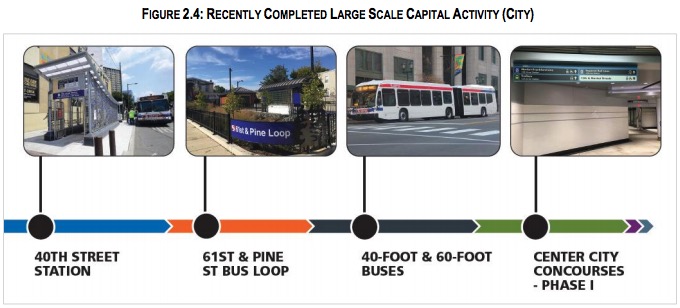About the Southeastern Public Transportation Authority (SEPTA)
 The Southeastern Pennsylvania Transportation Authority (SEPTA) is the nation’s sixth largest transit system, providing a vast network of fixed route services, ADA paratransit, and shared ride services for Bucks, Chester, Delaware and Montgomery counties. This coverage area spans 2,200 square miles and has a population of more than four million residents.
The Southeastern Pennsylvania Transportation Authority (SEPTA) is the nation’s sixth largest transit system, providing a vast network of fixed route services, ADA paratransit, and shared ride services for Bucks, Chester, Delaware and Montgomery counties. This coverage area spans 2,200 square miles and has a population of more than four million residents.
SEPTA operates 145 fixed routes through more than 2,700 vehicles across a variety of modes, including bus, subway, rail and trolley service (see Figure 1.1). SEPTA is also among the region’s largest employers, with a workforce of around 9,400. Its services carry more than 300 million passengers a year, and more than 1 million passengers each weekday. SEPTA’s transportation infrastructure and services are funded by a combination of passenger fares, and federal, Commonwealth and local funds.
The Commonwealth of Pennsylvania is a crucial investor in SEPTA’s infrastructure and services. Pennsylvania’s Act 44 of 2007 provides operating funding for SEPTA’s ongoing services. This funding was amended and expanded through Pennsylvania’s Act 89 in November 2013. This comprehensive transportation funding package set aside various funding streams for operating and capital funding for public transit on an ongoing basis, enabling SEPTA to significantly increase its capital activities to address a backlog of state of good repair projects and avert planned service reductions.
Southeastern Pennsylvania: the Economic Engine of the Commonwealth
Southeastern Pennsylvania is a key engine for Commonwealth’s economy. Despite occupying just 5 percent of Pennsylvania’s land area, the five-county region (Bucks, Chester, Delaware, Montgomery and Philadelphia counties) represent 32 percent of Pennsylvania’s population, and represent 41 percent of Pennsylvania’s gross economic product (see Table 1.1).
Due to this economic productivity, the southeast region is an outsized contributor to the Commonwealth’s general fund. Approximately 36 percent of the general fund revenues are estimated to originate in the five-county region (see Table 1.2). This contribute totals an estimated $10.8 billion of the Commonwealth’s $30 billion general fund.
This productivity has also made the southeast region an engine of growth for the Commonwealth. Census Bureau data on population growth by county from 2010-2016 shows that the southeast region has grown by more than 80,000 people from July 1, 2010 to July 1, 2016, while Pennsylvania’s population growth over that time period is roughly 72,000. That means that the southeast region has represented more than the total population growth of the Commonwealth during that six-year period (see Table 1.3).
This population growth is indicative of the impact of transit service on enabling density, growth and development. Southeastern Pennsylvania’s businesses count on a network of reliable and frequent transit services to directly transport employees as well as to reduce traffic congestion on the region’s highway and road network. All residents of the region benefit from SEPTA, including those who are not direct users of the service, because it is critical to the economic vibrancy of the region. In turn, the economic productivity of the southeastern region is key to the tax base of the Commonwealth, benefiting residents across Pennsylvania.
SEPTA’s Economic Footprint
In addition to the impact of SEPTA’s service on regional productivity (as discussed in Section 1) and development patterns (as discussed in Section 3), SEPTA is itself an economic generator through its capital and operating expenditures each year.
SEPTA is a major initiator of capital projects for the maintenance and expansion of its network. Since the passage of Act 89, SEPTA’s annual capital investments have increased significantly, growing the economic impact of this activity. SEPTA is also a major hub of employment throughout the region and procurement activity throughout the region and Commonwealth through its day to day mission as a transportation operator. These direct expenditures on capital and operating activity in turn generate significant “spillover impacts,” supporting employment in a range of sectors across the economy.
Capital Investments Since ACT 89
As of 2013, SEPTA faced a backlog of more than $5 billion in capital replacement needs including critical infrastructure and aging vehicles. The lack of a reliable funding stream limited the amount of activity that SEPTA could undertake on an annual basis reduced its borrowing capabilities.
This critical shortage forced SEPTA to develop a “Realignment Plan” which called for a significant downsizing of its network through 2023 to match ensure safety and reliability under available funding conditions. This included the suspension and truncation of several Regional Rail lines, forced conversion of trolley service to bus service, and reductions of service frequency throughout the network (see Figure 2.1).
In November 2013, the Pennsylvania Legislature passed Act 89, which provided dedicated long-term funding source for capital projects and a near doubling of SEPTA’s annual capital budget. As this legislation took effect in 2014, SEPTA was ready to efficiently invest the new capital dollars for long needed maintenance, state of good repair capital refurbishments, and replacement of vehicles. SEPTA is now four years into a 20-year capital program that addresses its long-standing backlog and creates the opportunity to consider much needed expansion to meet the needs of private sector and population growth across the region.
Figure 2.2 below shows SEPTA’s annual capital expenditures over the FY 2012-2017 period. In the three years prior to Act 89 (FY 2012-2014), SEPTA’s capital expenditures averaged $315 million per year (in current dollars). With the passage of Act 89, the annualized level increased to $529 million from FY 2015-2017 (see Figure 2.2).
Completed Capital Projects
These additional funds through Act 89 have allowed SEPTA to pursue critical infrastructure projects across the network. Large scale capital projects have been completed across suburban and city locations over the past three years (see Figure 2.3 and Figure 2.4).
- Crum Creek Viaduct: The 915-foot Crum Creek Viaduct on the Media/Elwyn Regional Rail Line was originally constructed in 1895, and had reached the end of its useful life. In 2017, SEPTA completed the replacement of the Viaduct for nearly $90 million.
- Lansdale Station Parking Garage: At one of its busiest Regional Rail stations, SEPTA undertook the construction of a fully accessible parking garage, a new bus laydown area, and a new neighborhood station. The $43 million project was completed in 2017.
- Lenni Substation: The Lenni Substation on the Media/Elwyn Regional Rail Line in Delaware County was overhauled in 2016. This $10.5 million project replaced the major power components that were originally installed in the 1920s.
- Frazer Yard – Phase 1: To accommodate the forthcoming expansion of railcar and locomotive fleets, SEPTA is upgrading the Frazer Maintenance Facility in Chester County by adding storage tracks and making major upgrades to existing structures. This $139 million project will be implemented in phases, the first of which was completed in 2017.
- 40th Street Station: The 40th Street Station on the Market-Frankford Line has been made fully ADA accessible by improving the platforms and stairways, installing elevators, and upgrading the safety features and lights. This $11 million project was completed in 2017.
- 61st & Pine Street Bus Loop: From FY 2016 – 2020, SEPTA has worked to improve multiple bus and trolley loops by adding accessibility features and improving operator bathroom facilities, platforms, lighting, and landscaping. SEPTA invested $1.8 million in improvements and additions at the 61st & Pine Street Bus Loop construction which was completed in the Fall of 2017.
- 40-foot & 60-foot Buses: SEPTA’s Bus Purchase Program turns over approximately 100 buses per year on average. Over the next five years, SEPTA will be adding 550 new 40-foot hybrid and electric buses to their fleet.
- Center City Concourses – Phase 1: The first phase of the multiphase renovations to the Center City Concourses will be completed by the summer of 2018 and will focus on the South Broad concourse. In early stages of the project, escalators and elevators have been replaced and structural enhancements and repairs have been made to improve the safety and accessibility of the concourses. The eight phase project is expected to cost approximately $60 million.
Another critical infrastructure upgrade to enhance SEPTA’s safety program was the successful implementation of Positive Train Control (PTC) across SEPTA rail network. In spring 2017, SEPTA became one of the first agencies to fully install and begin operation of this federally mandated technology. The PTC system enhances rider and worker safety by regulating train speed and separations, preventing potential collisions or errors.
Download full version (PDF): SEPTA Drives the Economy of Pennsylvania
Tags: PA, Pennsylvania, Philadelphia, SEPTA, Southeastern Pennsylvania









 RSS Feed
RSS Feed